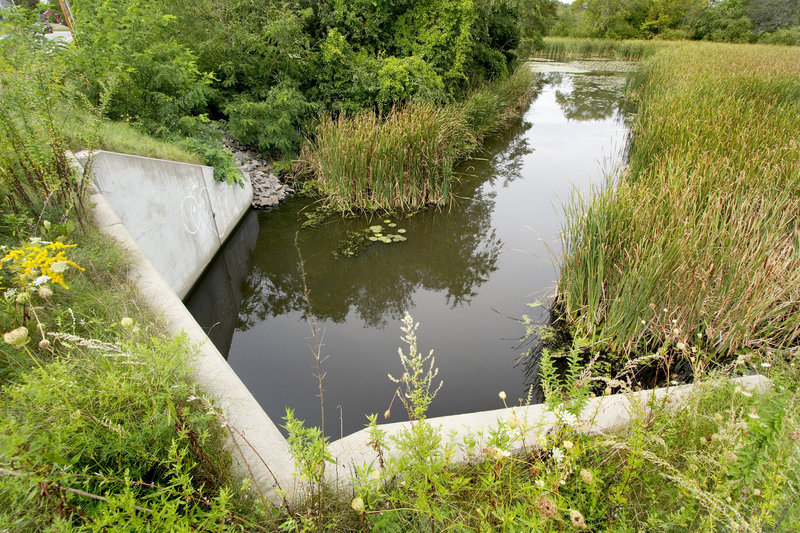PORTLAND — The Planning Board on Tuesday will consider a plan to restore the Capisic Brook Watershed.
The watershed — made up of more than 1,400 acres stretching from Westbrook to Warren Avenue and feeding Capisic Pond — feeds the 2.5-mile-long Capisic Brook, an urban impaired stream that does not meet minimum standards of the Clean Water Act.
City officials, along with consultant Woodard and Curran, have spent nearly three years studying ways to improve water quality in a complex watershed of roughly 2,800 residential properties and numerous commercial and industrial properties.
“We have a lot of things going on,” said Douglas Roncarati Jr., the city’s stormwater program coordinator.
Roncarati said the presence of metals, nutrients and bacteria in the brook has made it uninhabitable for fish, turtles and other wildlife. Nearly 30 percent of the watershed is roads, parking lots, buildings and other impervious surfaces that during the summer can increase water temperatures by 20 to 30 degrees, he said.
“All of these things together can impact the fish and what they eat,” he said. “And the impact runs up the food chain.”
The Capisic Brook Watershed Management plan outlines more than $13 million in stormwater upgrades and maintenance efforts needed over the next 10 to 15 years to clean up the watershed.
“It’s taken a long time for this watershed to become impaired,” Roncararti said. “And it’s going to take quite some time and investment of effort from our community and from city staff to try to do this.”
The projects will likely be funded, in part, by a new stormwater fee slated to go into effect next summer. Other funding sources include grants and compensation fees from developments.
Development of the plan was funded by a nearly $100,000 grant form the American Recovery and Reinvestment Act of 2009. The Casco Bay Estuary Partnership contributed $11,000 to the effort.
Commercial and industrial properties account for 25 percent of the watershed and are mostly responsible for the runoff carrying metals (such as zinc, lead and copper) and toxins (such as anti-freeze, oil and gasoline) into the watershed, which eventually drains to the Fore River, according to a planning memo.
The management plan recommends:
• Identifying potential sources of pollution flowing off each site, and using regular high-efficiency street sweeping and material handling and storage to reduce pollutants;
• More sophisticated stormwater treatment systems for major roadways and public properties;
• Extensive outreach to residential property owners, who comprise 35 percent of the watershed. Residential properties are largely responsible for the high levels of nutrients and bacteria in runoff, which can lead to algae blooms.
Two Combined Sewer Overflows also contribute to the bacteria levels, but those are currently being fixed. Roncarati said dog waste is “underestimated” as a pollutant.
Roncarati said it’s important to educate homeowners about ways to enhance their properties without using pesticides or fertilizers.
The plan also calls for a review of city policies governing development to encourage developers to get creative when it comes to low impact designs. Reducing parking requirements and installing rain gardens, green groves, gravel wetlands, porous pavement and shade trees are all on the table, he said.
Andy Graham has lived next to Capisic Park since 1978. He has watched wildlife disappear, the brook wither and the pond become filled with sediment and cattails.
Graham said he is most excited about portions of the plan that call for better treatment of stormwater runoff from the 26 miles of roadways that account for 25 percent of impervious surface.
Graham said it’s exciting to see the city is looking to make significant investments into the areas, including Sagamore Village, Riverside Street and Larrabee Road, rather than viewing waterways as “a convenient place to put stormwater.”
“Natural assets in Portland have been overlooked for a long time,” he said. “It’s great to see the city realizing the value of these assets.”
While increasing treatment plays an important role in cleaning up the watershed, it’s not always the most financially feasible option, Roncarati said.
“I can’t overemphasize the fact that it costs a lot less money if businesses and residents can try to keep the pollution out of our system, than trying to take it out once it’s in there,” he said.
Staff Writer Randy Billings can be contacted at 791-6346 or at:
rbillings@mainetoday.com
Twitter: @randybillings
Send questions/comments to the editors.




Success. Please wait for the page to reload. If the page does not reload within 5 seconds, please refresh the page.
Enter your email and password to access comments.
Hi, to comment on stories you must . This profile is in addition to your subscription and website login.
Already have a commenting profile? .
Invalid username/password.
Please check your email to confirm and complete your registration.
Only subscribers are eligible to post comments. Please subscribe or login first for digital access. Here’s why.
Use the form below to reset your password. When you've submitted your account email, we will send an email with a reset code.